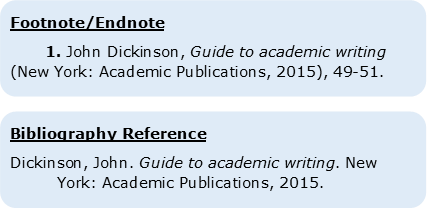

appears (do not cite the figure on its own in a bibliography entry). The Chicago Referencing Style Notes and Bibliography system (sometimes referred to as Chicago Footnote) requires: footnotes on each page within the text where you are referencing, a bibliography at the end of your document listing all the works that you have cited and any other works you have consulted.
In bibliography entries, cite the main text in which the figure/diagram/etc. In Chicago notes and bibliography style, you can use either footnotes or endnotes, and citations follow the same format in either case. In footnotes, include the page number on which the figure/diagram/etc. appears, place this before the number of the figure/diagram/etc., and separate these two elements of the footnote with a comma. Is the figure/diagram/table from a journal article? Format the main part of your footnote using the journal article template! Does the figure/diagram/table appear in a book? Follow the book citation formatting for the main part of the footnote. 
may be used when citing a figure for tables, maps, plates, diagrams, and other illustrations, spell out the label (e.g. Chicago footnote examples In text: Frankl recalls the physical trials of his imprisonment, such as working in torn shoes or lacking protection from the weather.
According to the Chicago Manual of Style Online, Section 14.158: Citing illustrations and tables, the abbreviation for figure - fig. If at all possible, cite the original source for the figure/diagram/table/musical example! 
This template applies when you need to cite a figure/diagram/table/musical example that has been published elsewhere by an author who is different than the author of the main text in which the item appears.







 0 kommentar(er)
0 kommentar(er)
